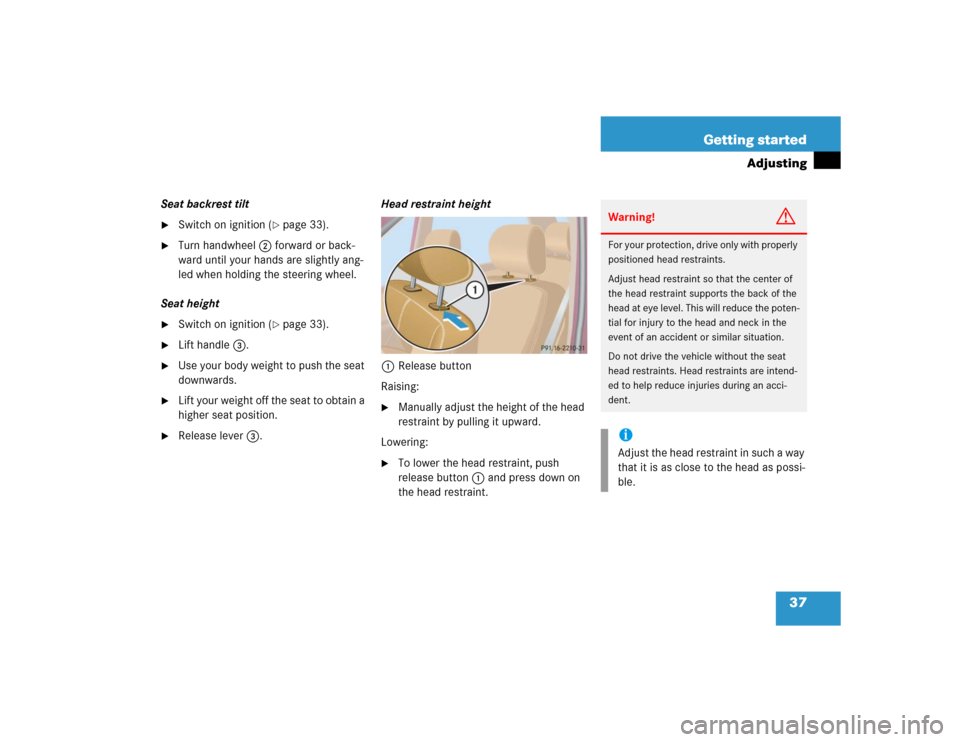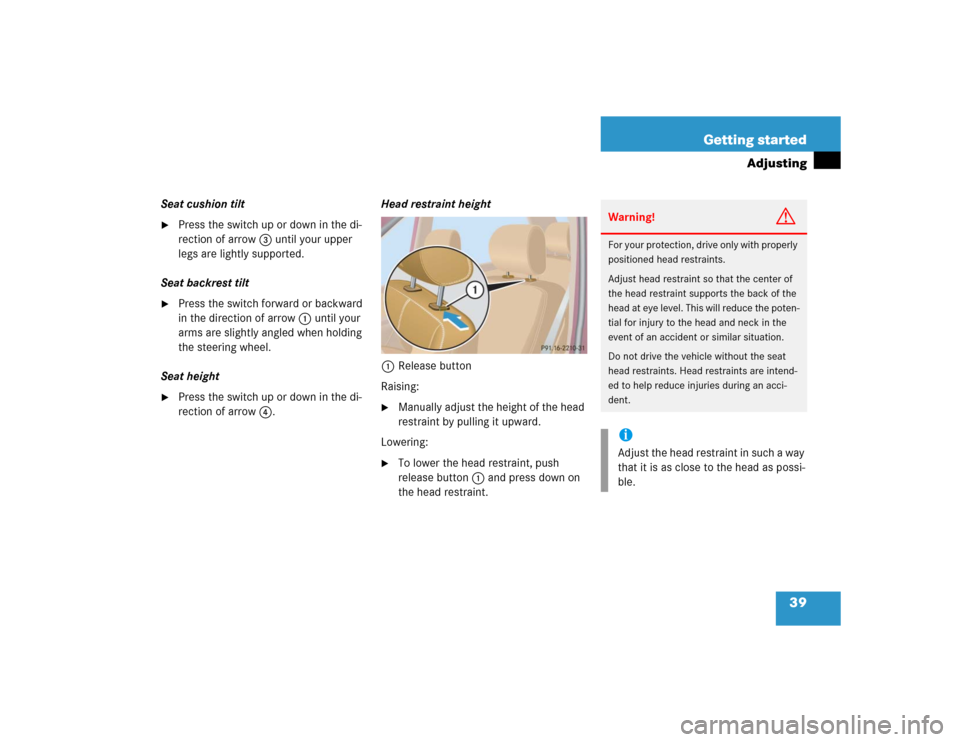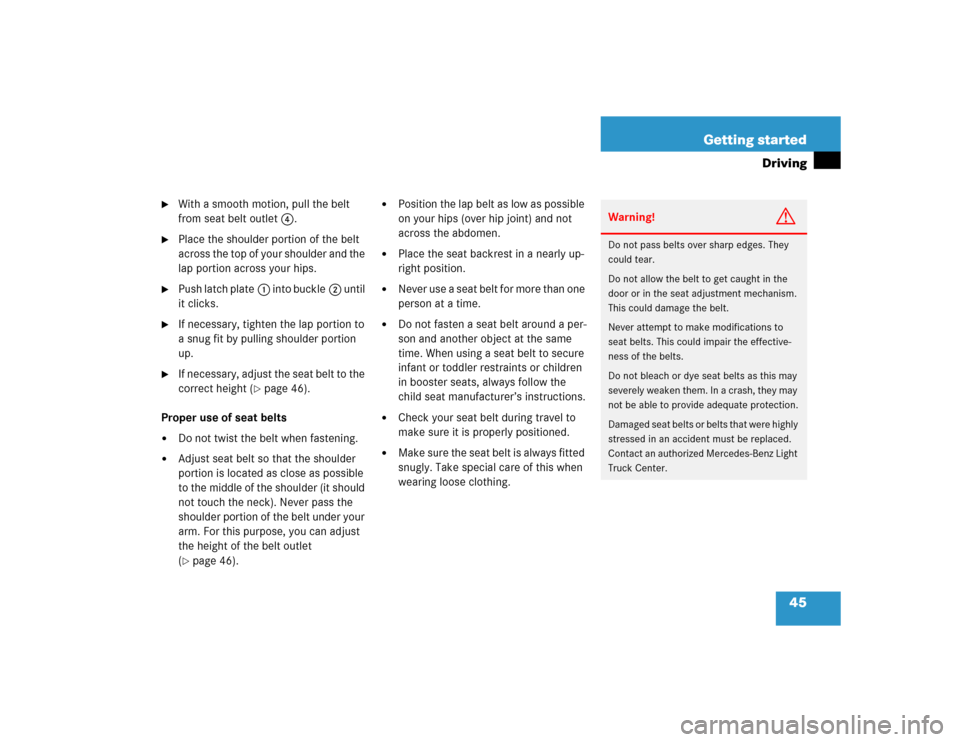Page 25 of 356
23 At a glance
Cockpit
Item
Page
1
Hood lock release
222
2
Parking brake pedal
54
3
Parking brake release
54
4
Left cup holder
169
5
Combination switch�
Exterior lights
�
High beam
�
Turn signals
50
6
Cruise control lever
153
7
Instrument cluster
117
8
Hazard warning flasher
switch
113
9
Lever for voice control
system*, see separate
operating instructions
Item
Page
a
Windshield wiper / washer
switch
51
b
Front Parktronic* warning
indicator
158
c
Glove box
167
d
Right cup holder
169
e
Storage compartment
f
Electrical outlet
173
g
Horn
h
Headlamp washer button*
133
j
Steering lock with ignition
33
k
Steering wheel lever
40
Page 30 of 356
28 At a glanceCenter consoleLower part
Item
Page
1
Ashtray with cigarette
lighter
171
2
Gear selector lever for
automatic transmission
47
3
Power window switch, right
front door
146
4
Power window switch, right
rear door
146
5
Parktronic system*
deactivation switch
159
6
Storage compartment with
cup holder
169
Item
Page
7
Exterior rear view mirror
adjustment switch
41
Exterior rear view mirror
electrically folding*
130
8
Central locking switch
93
9
Power window switch, left
rear door
146
a
Switch for rear door win-
dow override
74
b
Power window switch, left
front door
146
Page 31 of 356
29 At a glance
Overhead control panel
�Overhead control panel
Item
Page
1
Front left interior lighting
114
2
Signal transmitter buttons
for garage door opener
183
3
Front right interior lighting
114
4
Roadside Assistance
button
178
Information button
180
5
Interior lighting control
114
6
Trip computer* display
189
7
Rear view mirror
128
Item
Page
8
Right reading lamp on / off
115
9
Automatic antiglare func-
tion* on / off
128
a
Left reading lamp on / off
115
b
Glass breakage sensor
84
c
Trip computer* control
189
Tow-away alarm switch
85
d
Tele Aid* (emergency call
system) button
174
e
Tilt / sliding sunroof*
switch
150
Page 35 of 356

33 Getting started
Unlocking
Steering lock positionsSteering lock0For removing key
The steering is locked when the key is
removed from the steering lock. If
necessary, move steering wheel
slightly to allow the locking mechanism
to engage.
1Unlocking steering
Power supply to some electrical con-
sumers, such as seat adjustment.2Ignition (power supply for all electrical
consumers) and driving position
All lamps in the instrument cluster
come on. If a lamp in the instrument
cluster fails to come on when the igni-
tion is switched on, have it checked
and replaced if necessary. If a lamp in
the instrument cluster remains on after
starting the engine or comes on while
driving, refer to “Lamps in instrument
cluster” (
�page 248).
3Starting position
Warning!
G
When leaving the vehicle, always remove the
key from the steering lock and lock the vehi-
cle. Do not leave children unattended in the
vehicle, or with access to an unlocked vehi-
cle. Unsupervised use of vehicle equipment
may cause an accident and / or serious per-
sonal injury.iWhen you switch on the ignition, the in-
dicator and warning lamps in the instru-
ment cluster come on. This indicates
that the respective systems are opera-
tional. They should go out when the en-
gine is running.
Page 36 of 356
34 Getting startedUnlockingFor more information, see “Remote control
with folding key” (
�page 88).
iThe key can only be withdrawn in
position0.
If necessary, move steering wheel
slightly to allow the key to be turned
clockwise to position1.
A warning sounds when the driver’s
door is opened and the key is in steer-
ing lock position0 or1.
The key can only be removed from the
steering lock with the gear selector le-
ver in positionP.!To prevent accelerated battery dis-
charge and a possible dead battery, al-
ways remove the key from the steering
lock when the engine is not in opera-
tion.
Page 39 of 356

37 Getting started
Adjusting
Seat backrest tilt�
Switch on ignition (
�page 33).
�
Turn handwheel2 forward or back-
ward until your hands are slightly ang-
led when holding the steering wheel.
Seat height
�
Switch on ignition (
�page 33).
�
Lift handle3.
�
Use your body weight to push the seat
downwards.
�
Lift your weight off the seat to obtain a
higher seat position.
�
Release lever3.Head restraint height
1Release button
Raising:
�
Manually adjust the height of the head
restraint by pulling it upward.
Lowering:
�
To lower the head restraint, push
release button1 and press down on
the head restraint.
Warning!
G
For your protection, drive only with properly
positioned head restraints.
Adjust head restraint so that the center of
the head restraint supports the back of the
head at eye level. This will reduce the poten-
tial for injury to the head and neck in the
event of an accident or similar situation.
Do not drive the vehicle without the seat
head restraints. Head restraints are intend-
ed to help reduce injuries during an acci-
dent.iAdjust the head restraint in such a way
that it is as close to the head as possi-
ble.
Page 41 of 356

39 Getting started
Adjusting
Seat cushion tilt�
Press the switch up or down in the di-
rection of arrow3 until your upper
legs are lightly supported.
Seat backrest tilt
�
Press the switch forward or backward
in the direction of arrow1 until your
arms are slightly angled when holding
the steering wheel.
Seat height
�
Press the switch up or down in the di-
rection of arrow4.Head restraint height
1Release button
Raising:
�
Manually adjust the height of the head
restraint by pulling it upward.
Lowering:
�
To lower the head restraint, push
release button1 and press down on
the head restraint.
Warning!
G
For your protection, drive only with properly
positioned head restraints.
Adjust head restraint so that the center of
the head restraint supports the back of the
head at eye level. This will reduce the poten-
tial for injury to the head and neck in the
event of an accident or similar situation.
Do not drive the vehicle without the seat
head restraints. Head restraints are intend-
ed to help reduce injuries during an acci-
dent.iAdjust the head restraint in such a way
that it is as close to the head as possi-
ble.
Page 47 of 356

45 Getting started
Driving
�
With a smooth motion, pull the belt
from seat belt outlet4.
�
Place the shoulder portion of the belt
across the top of your shoulder and the
lap portion across your hips.
�
Push latch plate1 into buckle2 until
it clicks.
�
If necessary, tighten the lap portion to
a snug fit by pulling shoulder portion
up.
�
If necessary, adjust the seat belt to the
correct height (
�page 46).
Proper use of seat belts
�
Do not twist the belt when fastening.
�
Adjust seat belt so that the shoulder
portion is located as close as possible
to the middle of the shoulder (it should
not touch the neck). Never pass the
shoulder portion of the belt under your
arm. For this purpose, you can adjust
the height of the belt outlet
(�page 46).
�
Position the lap belt as low as possible
on your hips (over hip joint) and not
across the abdomen.
�
Place the seat backrest in a nearly up-
right position.
�
Never use a seat belt for more than one
person at a time.
�
Do not fasten a seat belt around a per-
son and another object at the same
time. When using a seat belt to secure
infant or toddler restraints or children
in booster seats, always follow the
child seat manufacturer’s instructions.
�
Check your seat belt during travel to
make sure it is properly positioned.
�
Make sure the seat belt is always fitted
snugly. Take special care of this when
wearing loose clothing.
Warning!
G
Do not pass belts over sharp edges. They
could tear.
Do not allow the belt to get caught in the
door or in the seat adjustment mechanism.
This could damage the belt.
Never attempt to make modifications to
seat belts. This could impair the effective-
ness of the belts.
Do not bleach or dye seat belts as this may
severely weaken them. In a crash, they may
not be able to provide adequate protection.
Damaged seat belts or belts that were highly
stressed in an accident must be replaced.
Contact an authorized Mercedes-Benz Light
Truck Center.